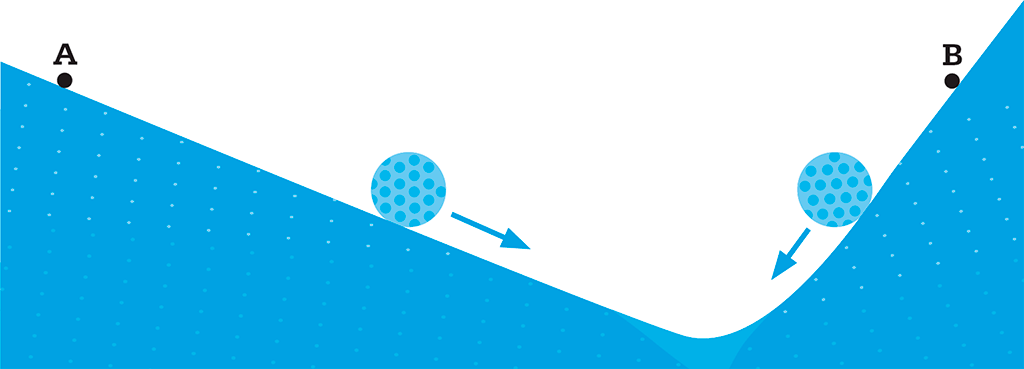
IN CONTEXT
Physics
4th century BCE Aristotle develops ideas about forces and motion, but does not test them experimentally.
1020 Persian scholar Ibn Sina (Avicenna) writes that moving objects have innate “impetus”, slowed only by external factors such as air resistance.
1586 Flemish engineer Simon Stevin drops two lead balls of unequal weight from a church tower in Delft to show that they fall at the same speed.
1687 Isaac Newton’s Principia formulates his laws of motion.
1971 US astronaut Dave Scott demonstrates Galileo’s ideas about falling bodies by showing that a hammer and a feather fall at the same rate on the Moon, which has almost no atmosphere to cause drag.
For 2,000 years, few people challenged Aristotle’s assertion that an external force keeps things moving and that heavy objects fall faster than lighter ones. Only in the 17th century did the Italian astronomer and mathematician Galileo Galilei insist that the ideas had to be tested. He devised experiments to test how and why objects move and stop moving, and was the first to work out the principle of inertia – that objects resist a change in motion and need a force to start moving, speed up, or slow down. By timing objects falling, Galileo showed that the rate of fall is the same for all objects, and came to realize the part played by friction in slowing them down.
With the equipment available during the 1630s, Galileo could not directly measure the speed or acceleration of freely falling objects. By rolling balls down one ramp and up another, he showed that the speed of a ball at the bottom of the ramp depended on its starting height, not on the steepness of the ramp, and that a ball would always roll up to the same height it had started from, no matter how steep or shallow the inclines were.
Galileo carried out his remaining experiments with a ramp 5m (16ft) long, lined with a smooth material to reduce friction. For timing, he used a large container of water with a small pipe in the bottom. He collected the water during the interval he was measuring, and weighed the water collected. By letting the ball go at different points on the ramp, he showed that the distance travelled depended on the square of the time taken – in other words, the ball accelerated down the ramp.

The law of falling bodies
Galileo’s conclusion was that bodies all fall at the same speed in a vacuum, an idea later developed further by Isaac Newton. There is a greater force from gravity on a larger mass, but the larger mass also needs a bigger force to make it accelerate. The two effects cancel each other out, so in the absence of any other forces, all falling objects will accelerate at the same rate. We see things falling at different rates in everyday life because of the effect of air resistance, which slows objects down at different rates depending on their size and shape. A beach ball and a bowling ball of the same size will initially accelerate at the same rate. Once they are moving, the same amount of air resistance will act on them, but the size of this force will be a much greater proportion of the downwards force on the beach ball than the bowling ball, and so the beach ball will slow down more.
Galileo’s insistence on testing theories with careful observation and measurable experiments marks him, like Alhazen, as one of the founders of modern science. His ideas on forces and motion paved the way for Newton’s laws of motion 50 years later and underpin our understanding of movement in the Universe, from atoms to galaxies.

Galileo demonstrated that the speed a ball reaches at the bottom of a ramp depends only on its starting height, not the steepness of the ramp. Here, balls dropped from points A and B will reach the bottom of the ramp at the same speed.
"Count what is countable, measure what is measurable, and what is not measurable, make it measurable."
Galileo Galilei
GALILEO GALILEI

Galileo was born in Pisa, but later moved with his family to Florence. In 1581, he enrolled in the University of Pisa to study medicine, then switched to mathematics and natural philosophy. He investigated many areas of science, and is perhaps most famous for his discovery of the four largest moons of Jupiter (still called the Galilean moons). Galileo’s observations led him to support the Sun-centred model of the Solar System, which at the time was in opposition to the teachings of the Roman Catholic Church. In 1633, he was tried and made to recant this and other ideas. He was sentenced to house arrest, which lasted the rest of his life. During his confinement, he wrote a book summarizing his work on kinematics (the science of movement).
Key works
1623 The Assayer
1632 Dialogue Concerning the Two Chief World Systems
1638 Discourses and Mathematical Demonstrations Relating to Two New Sciences
See also: Nicolaus Copernicus • Isaac Newton